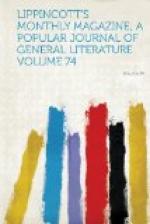Bowl-shaped, through tops of many thousand pines,
A gloomy-gladed hollow slowly sink
To westward; in the deeps whereof a mere,
Round as the red eye of an eagle-owl,
Under the half-dead sunset glared; and cries
Ascended.
Or this simple and beautiful sketch of crescent moonlight:
Silent
the silent field
They traversed. Arthur’s harp
tho’ summer-wan,
In counter motion to the clouds, allured
The glance of Gareth dreaming on his liege.
A star shot.
It is still, perfect, and utterly simple sketches like these, thrown off in the repose of power, that form the best setting for a heroic or poetical action: what better device was ever invented, even by Tennyson himself, for striking just the right note in the reader’s mind while thinking of a noble primitive knight, than that in another Idyl, where Lancelot went along, looking at a star, “and wondered what it was"? Of a more imaginative kind of beauty are the descriptions of the walls of rock near Castle Dangerous, decked by the hermit with tinted bas-reliefs, and the fine one of Camelot, looking as if “built by fairy kings,” with its city gate surmounted by the figures of the three mystic queens, “the friends of Arthur,” and decked upon the keystone with the image of the Lady, whose form is set in ripples of stone and crossed by mystic fish, while her drapery weeps from her sides as water flowing away. The most charming part of the character-painting is where the shrewish Lynette, as her estimate of the scullion-knight gradually rises in view of his mighty deeds, evinces her kindlier mood, not directly in speech, but by catches of love-songs breaking out of the midst of her scornful gibes: this is a very subtle and suitable and poetical way of eliciting the under-workings of the damsel’s mind, and it is continued through five or six pages in an interrupted carol, until at last the maiden, wholly won, bids him ride by her side, and finishes her lay:
O trefoil, sparkling on the rainy plain,
O rainbow, with three colors after rain,
Shine sweetly: thrice my love hath
smiled on me.
The allegory by which Gareth’s four opponents are made to form a sort of stumbling succession representing Morn, Noon, Evening, and Night or Death, is hardly worth the introduction, but it is not insisted upon: the last of these knights, besieging Castle Perilous in a skull helmet, and clamoring for marriage with Lynette’s sister Lyonors, turns out to be a large-sized, fresh-faced and foolish boy, who issues from the skull “as a flower new blown,” and fatuously explains that his brothers have dressed him out in burlesque and deposited him as a bugbear at the gate. This is not very salutary allegorizing, but it is soon over, and the poem closed, leaving a pleasant perfume in the reader’s mind of chivalry, errantry and the delicious days before the invention of civilization.




